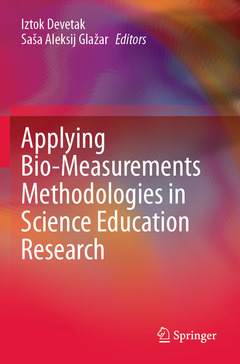Applying Bio-Measurements Methodologies in Science Education Research, 1st ed. 2021
Coordonnateurs : Devetak Iztok, Glažar Saša Aleksij

Chapter 1. Cognitive Processes and Eye-Tracking Methodology (Anja Podlesek).- Chapter 2. The Interplay of Motivation and Visual Attention in Understanding Science Concepts (Mojca Juriševič).- Chapter 3. Predicting Task Difficulty by Means of Psychophysiology (Junoš Lukan).- Chapter 4. Discussion of Visual Attention for Solving Multiple Choice Science Problem: An Eye-Tracking Analysis (Miroslawa Sajka).- Chapter 5. The Application of Eye Tracking to Chemistry Education Research – A Review of the Literature (Jessica R. VandenPlas).- Chapter 6. Using Eye-Tracker to Study Students' Attention Allocation During Solving Tasks of Specific States of Water Comprising Dynamic 3D Submicrorepresentations (Miha Slapničar).- Chapter 7. Students' Attention Allocation when Solving a Context-based Problem of Process During the Opening of a Bottle of Mineral Water (Jerneja Pavlin).- Chapter 8. Using Eye-Tracking Approach to Explain Students’ Achievements in Solving the Task about Burning by Applying Chemistry Triplet (Iztok Devetak).- Chapter 9. Reading Organic Chemistry Equations: An Eye-Tracking Study (Katherine L. Havanki).- Chapter 10. The Role of the Explanatory Key in Solving Tasks Based on Submicroscopic Representations (Špela Hrast).- Chapter 11. Use of Eye-Tracking and Electroencephalography to Study Student Use of Metabolic Pathways when Answering a Question (Kimberly Linenberger Cortes).- Chapter 12. Using Functions to Interpret some Physics Phenomena – an Eye-tracking Study (Miroslawa Sajka).- Chapter 13. Eye Movements as Indicators of Students' Understanding of Water Ballance in Plants (Anja Podlesek).- Chapter 14. Visualizing Student Navigation of Geologic Block Diagrams (Karen S. McNeal).
Explores beyond paper-pencil measurements in researching teaching and learning science
Presents conclusions that can be implemented in successful teaching and learning
Examines the research of internationally respected science educators
Date de parution : 05-2022
Ouvrage de 311 p.
15.5x23.5 cm
Disponible chez l'éditeur (délai d'approvisionnement : 15 jours).
Prix indicatif 105,49 €
Ajouter au panierDate de parution : 05-2021
Ouvrage de 311 p.
15.5x23.5 cm
Disponible chez l'éditeur (délai d'approvisionnement : 15 jours).
Prix indicatif 105,49 €
Ajouter au panier


